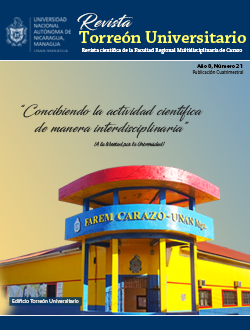An overview of Carazo department from the regional studies
DOI:
https://doi.org/10.5377/torreon.v8i21.8855Keywords:
historical region, ethnography, cultural ecology, integration and articulationAbstract
Located in the recent Nicaraguan regional historiography, promoted by the National Autonomous University of Nicaragua, Managua (UNAN-Managua) since the 1980s, this article aims to demonstrate that historical regions have integration and articulation dynamics that do not necessarily they correspond to the administrative political divisions of the territory. To explain this dynamic, the method of cultural ecology of anthropologist Julian Steward (1955) has been used, which proposes to understand the regions from its cultural nucleus, that is, the adaptation and interaction of man with his environment; Of course, ethnographic work has been fundamental. The results reveal that Carazo has four internal historical regions. Therefore, it could be concluded, among other things that both the political and regional divisions coexist without opposing each other, but regional understanding stands out as a possibility of shortening the center-periphery gap.
Downloads
Downloads
Published
How to Cite
Issue
Section
License
The authors who publish in this journal agree to the following terms.
- The author or authors of the articles, essays or research grant the National Autonomous University of Nicaragua, Managua (UNAN-Managua) the editing rights (copyright) of the submitted work, therefore the University has the exclusive right to publish the article for the entire copyright period.
- These copyrights/authors authorize Torreón Universitario Magazine and the University to edit and disseminate/publish the article in said Magazine, including printed and electronic reproduction, storage, retrieval and any other type of publication, and sources of secondary information as services. of summaries and databases, they also empower it to protect the article against unauthorized use for dissemination by printed or electronic media (PDF, HTML, EPUB, XML or others).
License for use of content
The magazine uses the Creative Commons Attribution-NonCommercial-NoDerivs 4.0 International License.
Under this statement:

This journal is licensed under a Creative Commons Attribution-NonCommercial-NoDerivatives 4.0 International License. It can be copied, distributed and transmitted publicly as long as the author and source are cited (Revista Torreón Universitario), it should not be modified or used for any commercial purpose. The full license can be found at http://creativecommons.org/licenses/by-nc-nd/4.0/.



